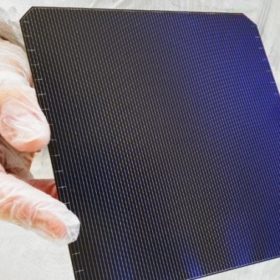
The efficiency of the solar cell, which is made with a standard M2 wafer, was raised by around 0.7% through an improved busbarless screen printing metallization process based on heterojunction (HJT) processes developed with manufacturing equipment provided by Swiss specialist Meyer Burger.
France’s solar energy research INES, part of the French Alternative Energies and Atomic Energy Commission (CEA), and renewable energy company Enel Green Power, a unit of power company Enel, claim to have achieved a 24.63% conversion efficiency for a heterojunction solar cell based on a standard M2 wafer.
“The result was confirmed by the German Institute for Solar Energy Research in Hamelin (ISFH),” a spokesperson for Enel told pv magazine.
The Italian company said that the bifacial cell’s frontside efficiency was raised by around 0.7% through an improved busbarless screen printing metallization process based on heterojunction (HJT) processes developed in cooperation between Enel and INES, on manufacturing equipment provided by Swiss specialist Meyer Burger.
Enel also explained that the increase in efficiency was made possible by combining busbarless technology, which allows more light to fall onto the cell surface, and a new treatment developed by INES and Enel, which further improved the cell passivation. “The process also requires less silver and is becoming cheaper,” the spokesperson stated.
He added that modules based on this cell technology with 23% efficiency are currently being manufactured at Enel’s solar module factory in Catania, southern Italy. “Our plan is to reach an average 24% efficiency in production in 2021 and this week’s new achievement is paving the way for this target to be reached,” he affirmed.
Enel Green Power started production of heterojunction modules at its 3Sun solar module factory in Catania, Sicily, in October 2019. The 200 MW facility manufactur bifacial solar panels with output up to 400 W and efficiency of more than 20.5%.
In December, the new energy technologies and nanomaterials (Liten) branch of the French Alternative Energies and Atomic Energy Commission announced to have achieved a 24.25% peak efficiency for a silicon heterojunction solar cell. In August, Hanergy set a new efficiency record for a silicon heterojunction module at 24.85%. That edged out the previous record of 24.5% held by Japanese company Kaneka, which still holds the record for heterojunction cell efficiency, at 26.7% on a slightly smaller cell.
Lắp đặt điện mặt trời Khải Minh Tech
https://ift.tt/2X7bF6x
0906633505
info.khaiminhtech@gmail.com
80/39 Trần Quang Diệu, Phường 14, Quận 3
Lắp đặt điện mặt trời Khải Minh Tech
https://ift.tt/2ZH4TRU
Không có nhận xét nào:
Đăng nhận xét